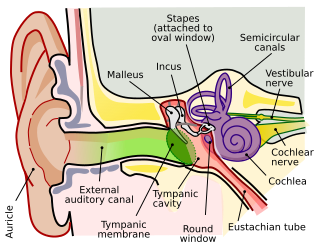This article has multiple issues. Please help improve it or discuss these issues on the talk page . (Learn how and when to remove these messages)
|
| Outer ear | |
|---|---|
 A diagram of the anatomy of the human ear: | |
 The auricula. Lateral surface. | |
| Details | |
| Identifiers | |
| Latin | auris externa |
| MeSH | D004431 |
| NeuroLex ID | birnlex_1705 |
| TA98 | A15.3.01.001 |
| TA2 | 6862 |
| FMA | 52781 |
| Anatomical terminology | |
 |
| This article is one of a series documenting the anatomy of the |
| Human ear |
|---|
The outer ear, external ear, or auris externa is the external part of the ear, which consists of the auricle (also pinna) and the ear canal. [1] It gathers sound energy and focuses it on the eardrum (tympanic membrane).


